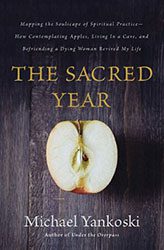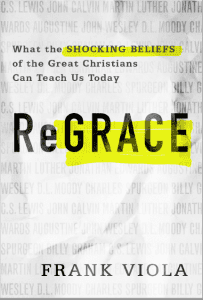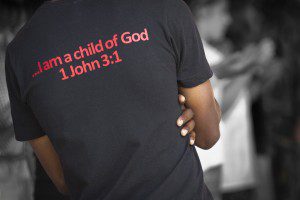 I began reading The Sacred Year the way I begin reading most books: on the treadmill.
I began reading The Sacred Year the way I begin reading most books: on the treadmill.
So my first observations about Michael Yankoski’s new work were important ones: specifically, that it is heavy and thick. Meaning this would need to be a speed-walk read (in which I hold the book in my hand while walking) rather than a sprint read (in which the book is thin enough to set on the small treadmill dashboard ledge, and I can pound away high-speed and hands-free).
As I opened to the first chapter, my phone buzzed: an email from one of my editors with a link to a movie I’ve been waiting to review. I went ahead and pulled it up on my iPad—which fits with supreme ease on the treadmill ledge—just to have it going in the background. I stuck in one earbud, leaving the other ear free to listen for my twin sons who were snoozing away in the next room. As the opening credits rolled, I turned back to the book.
A couple of sentences in, it occurred to me that this might be the boys’ last nap of the day, and I probably should check my social media accounts. Placing my bookmark (one of those green plastic Starbucks stoppers) carefully up against page one and tucking the book under my arm, I pulled out my phone again. In the process of replying to Facebook messages, Instagramming a picture of my morning coffee, and re-tweeting some cool quotes, I also got side-tracked on Amazon, where I (finally) downloaded Tina Fey’s Bossypants and loaded my shopping card up with important things like a camo Dallas Cowboys ball cap, two Fisher Price four-wheelers, a new Vera Bradley wristlet, and every book Richard Rohr ever wrote.
And this is the way I get 99% of my work done. (Or, if I’m being honest, more like 100%.)
Yes, I have read the studies that say humans only think they can multi-task, but I assure you: I completed a doctoral dissertation in the exact manner described above in only three years, which is pretty fast. I researched on the treadmill, conducted phone and Skype interviews on the treadmill, edited drafts on the treadmill, and I got that Ph.D. and was in the best shape of my life. Now, I have twin boys, and if I don’t carry out all professional business while working out, it may never get done. So, if there’s one practice I believe works, it’s multi-tasking, and no statistic or study on how the human mind literally can’t focus on more than one thing at a time would be likely to convince me otherwise.
Which is why it really must have been an act of God that led to my iPad suddenly falling off the treadmill ledge and to me, in the midst of trying to catch it and not have my ear yanked off by the attached earbud, dropping my iPhone. As I watched both glowing screens spin their way underneath the churning machine, I had one thought: So now what am I supposed to do for the next hour (because I have a policy to never stop the treadmill once I’ve started, which wastes precious workout time)?
Just read this book? Really?
So I tried it.
And it changed my life.
Seriously, if there is any single new book that will do your faith some serious good and that will contribute some positive food for thought to the lay-theological dialogue, a book that isn’t just another rehashing of the myriad improve-your-faith/improve-your-life books that sag the shelves of the Barnes and Noble Religion section and clog our Kindle memories on a daily basis, it’s this one.
I was not expecting to have such a strong response. In fact, when, in Chapter One, Yankoski writes of himself and the existential crisis that set off his search for a deeper faith that “I couldn’t help but wonder if I was just another pawn in the brightly lit song-and-dance called ‘American Christianity,’ leading a life offstage that didn’t actually warrant what I was saying on stage,” I almost started to skim. I was thinking: “I’vvveeee heard this story before: author feels fake; author comes up with a ten-step program to revolutionize his life and draw close to God; author publishes, and the burnt out rest-of-us, who are also caught up in the song-and-dance, flock like sheep to shell out our cash to and try the newest salvation fad.”
But something kept me from skimming (i.e., the fact that an hour is a long time to spend on a treadmill with nothing to do besides tread), and I am so glad I did not. Yankoski’s beautiful and poetic writing style is not only the sort that should be savored, but the content of this book is SO different, new, and really—hopefully for lots of readers—revolutionary, that it requires time to be absorbed and contemplated. In short, The Sacred Year is a synopsis of author Michael Yankoski’s year-long commitment to adopting both ancient and modern spiritual practices. The idea was to see to what kind of life-style and spiritual realignment they might lead.
This alone is something new. Be honest: when was the last time—in the evangelical church in particular—you heard the words “spiritual practice” mentioned? I, for one, have never. One year, when I was a senior in high school, I got really interested in Catholicism and learned about some things like confession and fasting and even took part a few times, but in general, I really related to Yankoski when he said that “As a Protestant, all that really came to mind when I heard ‘spiritual practice’ was quasi-erratic Bible reading and occasional, desperate prayers.”
So, on one level, I was blown away by the sheer education this book provides on the variety of spiritual practices that exist:
Attentiveness
Daily Examen
Sustenance
Simplicity
Creativity
Embracing Mortality
Confession
Listening Prayer
Lectio Divina
Regular Eucharist
Solitude
Sabbath
Wilderness
Pilgrimage
Gratitude
Protest
Pursuing Justice
Community
Caring
There is a chapter for each practice, and what you realize by the end of the book is that really any aspect of life can be spiritualized. As Father Solomon, one of Yankoski’s spiritual guru-friends, says: “Just about anything can become a spiritual practice.” And, by turn, what readers will find is that the spiritual practices can apply to our lives in any number of ways. The way in which they play out—what they look like in our daily lives—is open to our own interpretation. In one chapter, for example, to observe the spiritual practice of “Attentiveness,” Yankoski meditates on an apple, teaching himself to really observe and appreciate every sensory detail, learning to “single task.” In another, in practicing “Simplicity,” he purges his closet and learns to mend his own clothes instead of always buying new ones. As efforts in various other spiritual practices, he takes up pottery, digs a grave by hand, spends a week on silent retreat in a cave, and goes on a research trip to study the impact of unsafe water on the lives of families in Uganda. In other words, in both big and small ways, Yankoski reorients his life around the sorts of actions that lead towards, as Father Solomon says, “[h]elping [him] become more acquainted with who [he is], who God is, and the people he’s placed [him] into this life along side of,” what Yankoski describes as an effort in “adjusting our sails and making sure we’re in a receptive place given what God is doing.”
This is what Yankoski (and the many philosophers, poets, and theologians who inspire him) mean when they talk about life as a “way”: a path of growing closer to and working more in line with God. Spiritual practices—specific, planned actions that we commit to and focus on—keep us attune to and lead us down this path. Looking at life this way will undoubtedly be, for many readers, a paradigm shift. It certainly was for me.
Each chapter includes a definition of the spiritual practice, a wellspring of information about the practice’s history and spiritual significance, a description of Yankoski’s experience adopting it, and a reflection on what he learned. Yankoski has one of those minds that can leap from quoting the poetry of Elizabeth Barrett Browning at one moment to citing Wendell Berry, Augustine, Sophocles, or Martin Luther King, Jr. at the next. His knowledge of Scripture is of equal depth and breadth. Reading his work is like sitting at the foot of a truly wise teacher and getting to see up close the beautiful and fascinating workings of mind. (And then—via a Twitter conversation—I discovered Yankoski is only 31, which blew my mind for an entirely different reason!)
The writing in The Sacred Year is phenomenal. The message is phenomenal. The sheer number of moments that will take your breath awake poetically, spiritually, and intellectually is phenomenal. I have already started a list of the people who will be receiving this blessing of a book from me for Christmas. And already, I’m not even sure I can make it until Christmas to give it to them. I’ve already loaned my own copy out.
I must confess though: after turning the last page of The Sacred Year, I started to immediately grow nervous.
My mind was quickly consumed with one overwhelming question: “WHAT NOW?”
How do I even begin to apply all this information? I can’t afford to travel to Uganda! Maybe I should start on Monday. I could just do the apple thing. Or better yet, maybe I should start on New Year’s Day! Yes, 2015 would be a good time to start a Sacred Year. Am I going to have to give up Starbucks? Is Apple an ethical company to support? Do I hear a baby crying? The book didn’t talk about how to do this if you’re a parent! I should’ve done this while I was single! It’s too late for me now! Who has time to contemplate an apple for an hour when current free time is limited mostly to the five-minute intervals that the jumperoo and exersaucer are entertaining to six-month-old little boys. Maybe I’ll just try going to Confession. Are there even any Protestant churches around here that will do that with me? Should I go to a Catholic church? Is that okay to do? How about fasting? Ok, I’ll fast, but I really need to eat the last of the pumpkin cookies before they get stale first…
And so on.
This book will press you to ask “WHAT NOW?”—what I find to be one of life’s (and faith’s) most frightening of all questions—like nobody’s business.
And my mind was flooded with “WHAT NOW?”
But since I hopped off the treadmill that first day, I’ve started trying some things:
(1) I cleaned out my email. Sound like no big deal? Sound entirely unspiritual? It’s not. Simplifying all of the folders; deleting hundreds upon hundreds of out of date updates from students and faculty, countless out of date coupons from J. Crew and Pampers and Bass Pro Shop; responding to much-too-old messages; and finally getting my inbox down to—yes, for real—zero new messages, uncluttered my mind in a way you wouldn’t believe. I don’t dread the you’ve-got-mail buzz on my phone any more because I know it is only ONE message, and ONE message at a time I can handle. That small part of my life has been unburied, unearthed, unburdened, and that part of my mind is free now to appreciate and focus on other things.
(2) I started reading sitting down, sometimes in our beautiful sun room with the cathedral ceilings and skylights, sometimes with my feet propped up, not always with a cup of coffee, not always with a highlighter. I’m teaching my senses to revel in small beauties and simple moments. I’m training my mind to focus on one thing at a time. And, Yankoski was right, suddenly I’ve begun to notice how incredible God’s world really is. Not just in the obvious ways—the sunsets and the mountains and the oceans—but in smaller ways: the many and nameless shades of brown in a single piece of pine straw, the brush strokes in the paint on the flowerbox my father made by hand, the way a squirrel twitches its life away. How really very little we need to experience joy. How endless the delight—the Selah! as Yankoski says, quoting the Psalmist—around us really is.
I’m a major work in progress. But I know that. And I’m practicing being different.
And I think that’s the point.
I am grateful for this book.
And though it’s kind of weird to thank an author in a book review, I can’t help but say that I am grateful also for Michael Yankoski: his life, his bravery, his faith in faith, and his open-heartedness in sharing his experiences with the world. It is rare to find a voice so thoroughly humble combined with a personality so curious and a drive for God so persistent. Yankoski is not afraid to experiment and fail and experiment and find a kernel of hope and then share it with the world. We are—as he so rightly noted—each so desperately in need of waters that run deeper than the “song-and-dance” of faith that looks good on the outside but is dry as a bone beneath. The Sacred Year is not a book that will solve your problems. It is not a step-by-step guide. It does not have study questions. It does offer a way though. A new way that is an old way and that leads—I can tell you so because even in my own small first steps towards it, I can see it—closer and closer to the God that wants to walk with us and dwell with us and serve with us and love with us and reviveus. It’s a process. And it’s sacred. And, trust me, you want in.
Read an excerpt from The Sacred Year at the Patheos Book Club here.
 Amber M. Stamper holds a Ph.D. in English (Rhetoric and Composition) and is an Assistant Professor of Language, Literature, and Communication at Elizabeth City State University in North Carolina. Her research and publications center on religious rhetoric and communication, especially issues of Christian evangelism and the digital church.
Amber M. Stamper holds a Ph.D. in English (Rhetoric and Composition) and is an Assistant Professor of Language, Literature, and Communication at Elizabeth City State University in North Carolina. Her research and publications center on religious rhetoric and communication, especially issues of Christian evangelism and the digital church.












